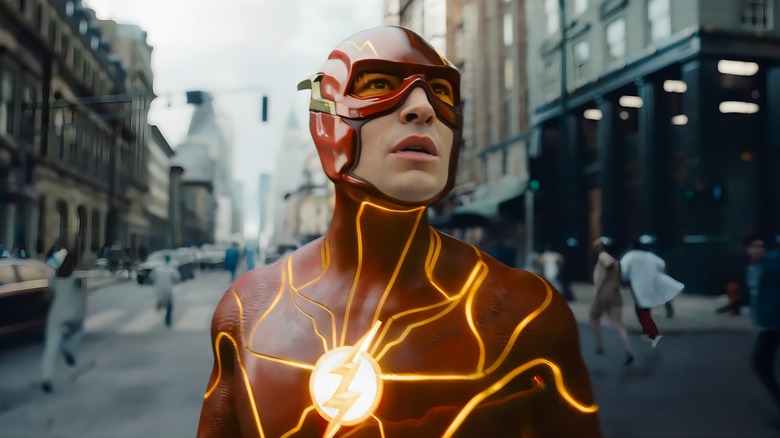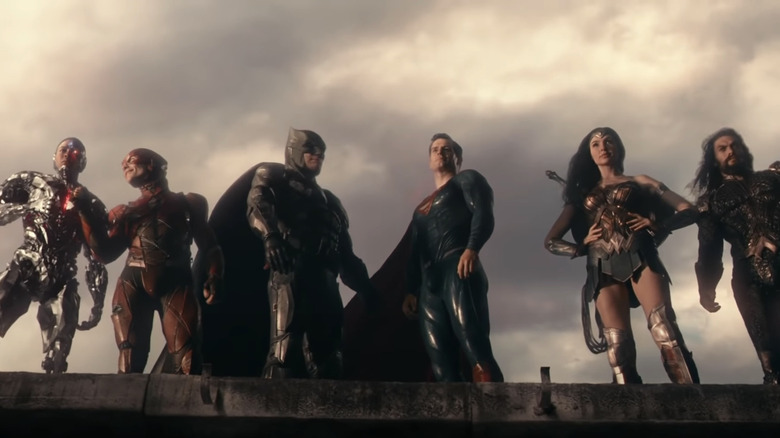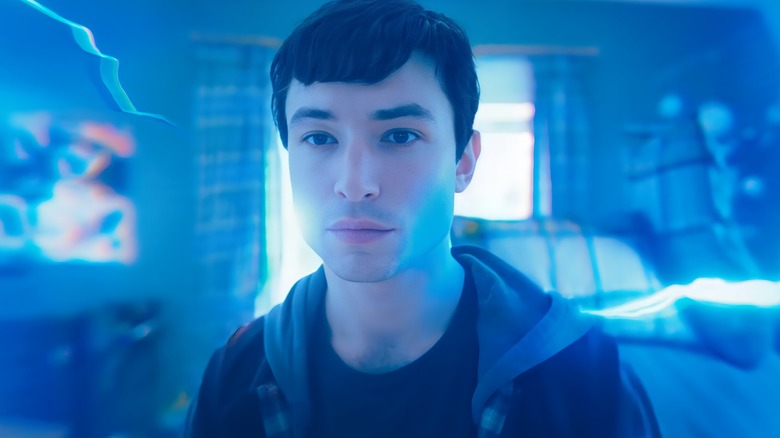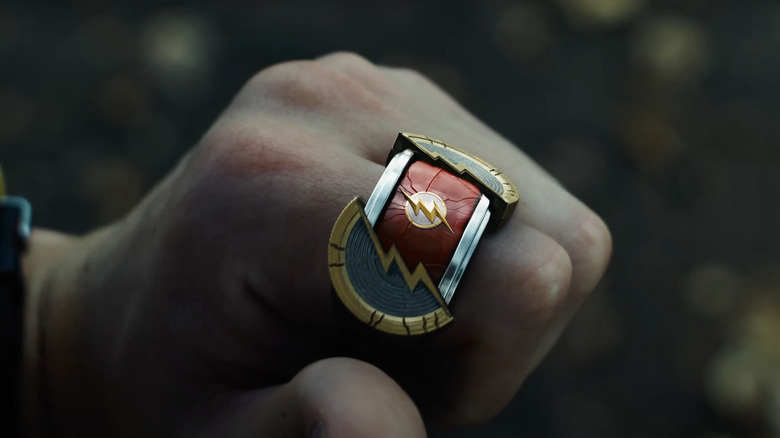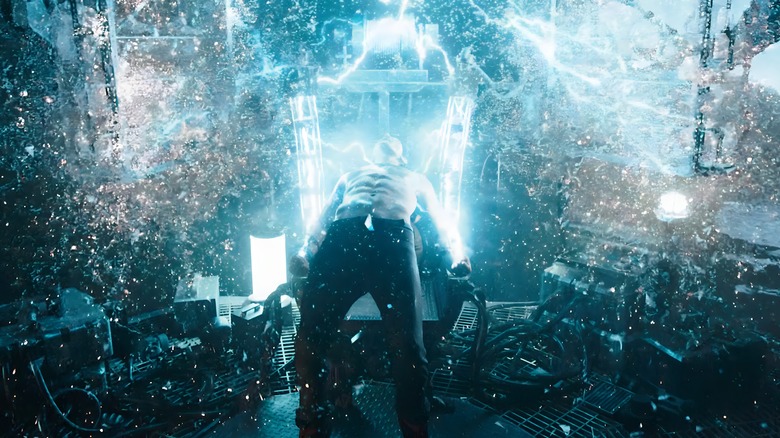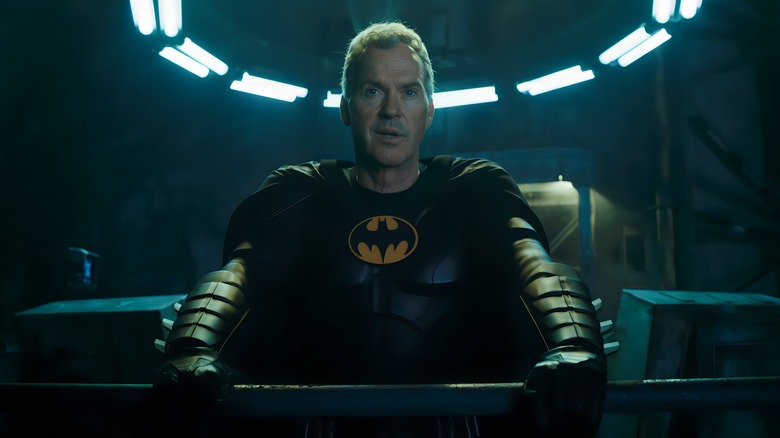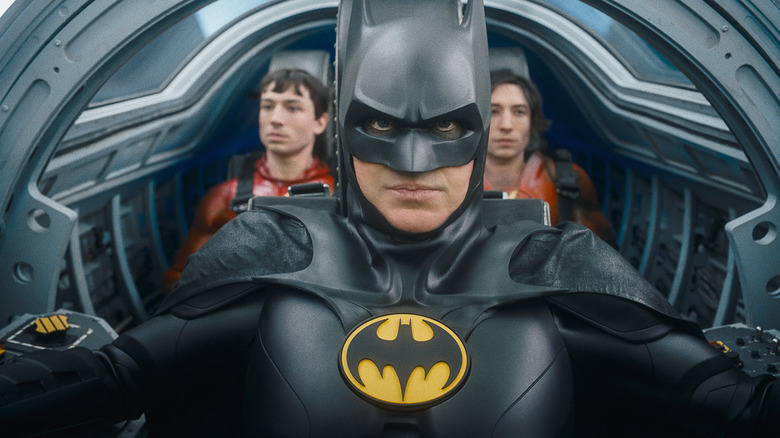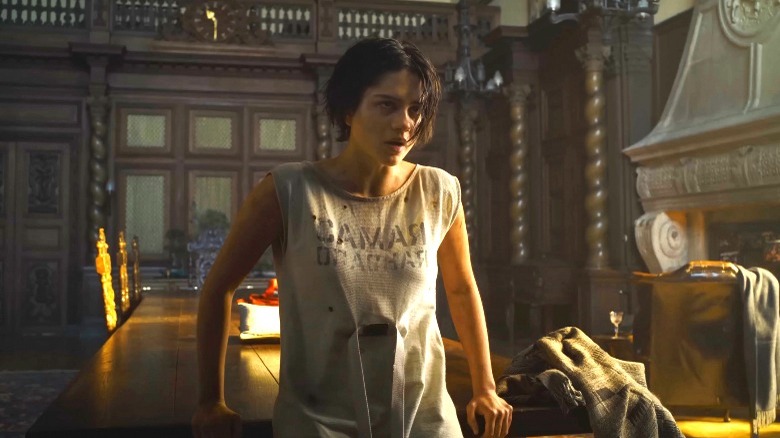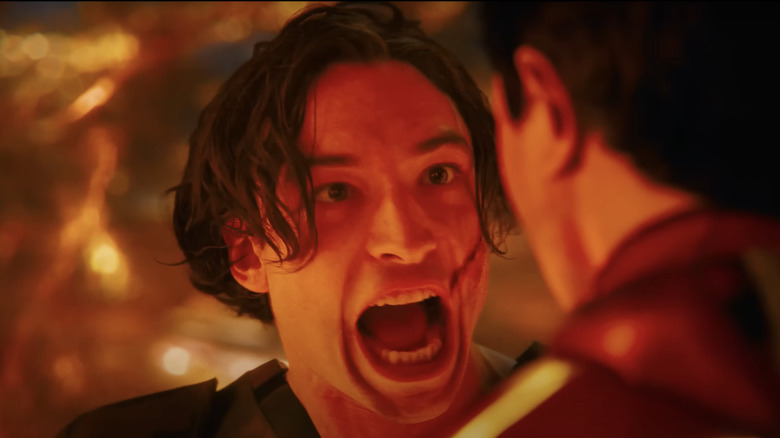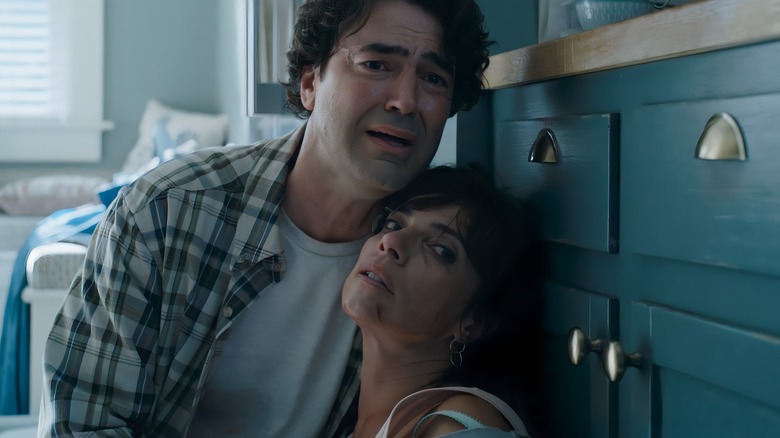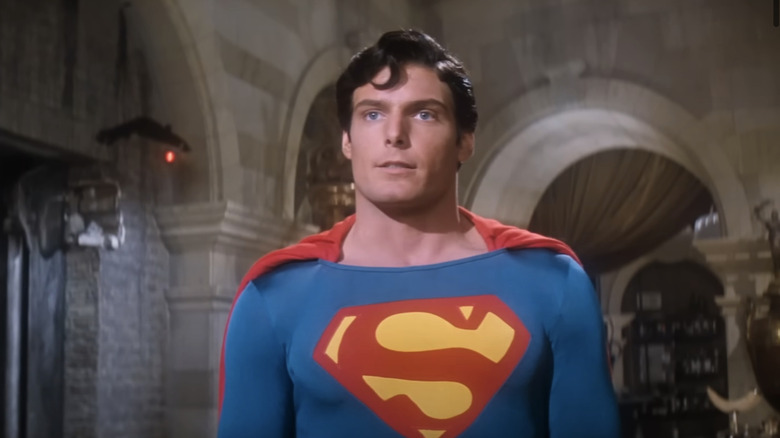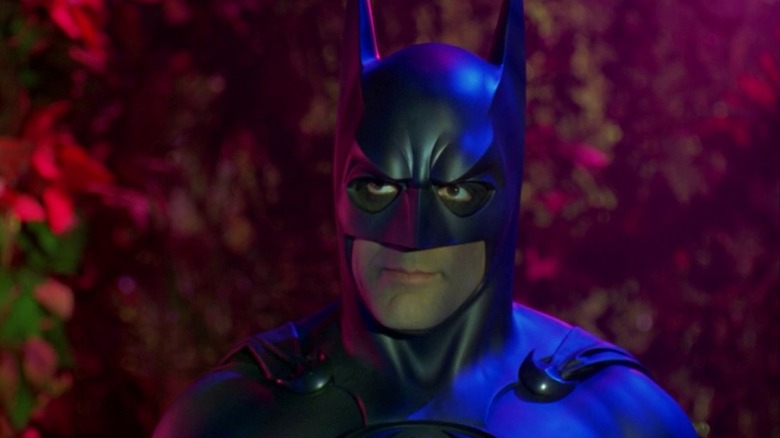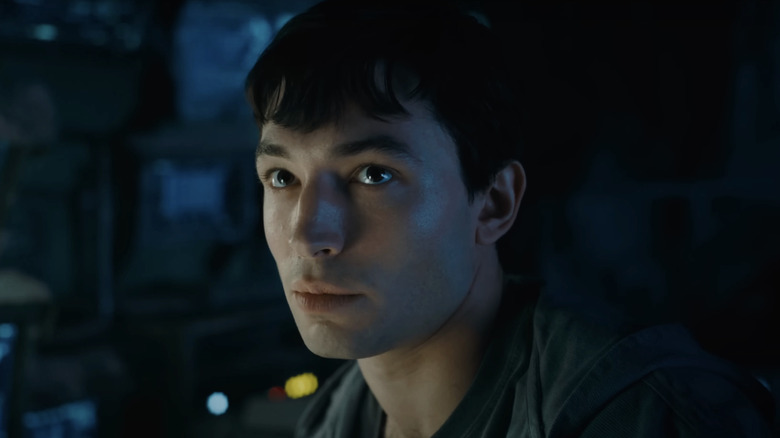The Flash's Most Confusing Moments Explained
Contains spoilers for "The Flash."
DC's "The Flash" solo movie is finally here, though it didn't arrive on the big screens as speedily as the scarlet speedster himself. The production of the film has a messy history behind it, including multiple changes in its writers and director, numerous rewrites, several delays, controversies surrounding its lead star, and the ultimate restructuring of DC Studios under new heads, James Gunn and Peter Safran.
"The Flash" follows Barry Allen (Ezra Miller) as he goes back in time to save his mother, only to realize the drastic and violent consequences of his actions in changing the timeline. Without the Justice League's help, joining Barry is a ragtag team of a younger, inexperienced version of himself, an older and rusty Batman (Michael Keaton), and Supergirl (Sasha Calle). The film is anticipated to be the bridge between the messy DC Extended Universe and Gunn's new DC Universe, given the film's timeline-altering plot.
With its time-traveling hijinks, host of characters both new and old, and many surprising (and not-so-surprising) cameos, the plot can get pretty confusing at times, and difficult for the audiences to be up to speed about everything. So try to keep up as we explain the most confusing moments in "The Flash."
How long after Justice League does The Flash take place?
The theatrical version of "Justice League," which is considered to be DCEU canon by Warner Bros., is set in 2017. It's a general assumption that DCEU movies are set in the year they're released, unlike the current line-up of MCU movies and TV series, where each entry is set three years ahead of its release (thanks to the Blip). Hence, "The Flash" takes place in 2023 — six long years after the last time we saw the League together. A lot has happened in-universe since then; for example, Barry had gotten a new suit and new powers.
Most members of the League had made separate appearances in other DCEU media in the time since the 2017 team-up movie, many of which were without the actual actors reprising their roles. While the League appeared in the finale of "Peacemaker," only Ezra Miller and Jason Momoa returned as Flash and Aquaman, respectively, with the other characters obscured in shadows.
A tie-in three-issue comic series, titled "The Flash: Fastest Man Alive," was released in 2022 to bridge the gap between 2017's "Justice League" and 2023's "The Flash. The series follows Barry as he struggles to balance his life as a solo superhero in Central City and his job at the CCPD Crime Lab, occasionally receiving mentorship and assistance from Batman.
When did Barry learn to phase through objects?
While phasing through solid matter is one of Flash's many powers in the comic books, it was never established in the DCEU movies until "The Flash." In the film, Barry uses his "phasing" ability to infiltrate rooms, dodge projectiles, and steal some beer from his neighbors. When Prime Barry, carrying Young Barry, infiltrates the Central City Police Department by phasing through a door, a microscopic zoom-in shows how his molecules vibrate to pass through the molecules of the door.
While "The Flash" never explains how Barry received this new (and very useful) power, in the second issue of the tie-in comic book prequel, "The Flash: The Fastest Man Alive," Barry finds his entire body uncontrollably vibrating during a fight against Tarpit. After a bit of trial and error with this new peculiarity (including accidentally exploding a car just by touching it), Barry discovers that if he maintains his vibrative state whilst interacting with objects, he's able to "phase" through solid objects.
While the power does have its benefits, like dodging bullets and attacks, it does have its drawbacks when not used properly, like when the inexperienced Young Barry accidentally phases through the floor into his downstairs neighbor while completely naked.
How did Barry get his new suit?
It's very common now for comic book characters to wear new suits in each franchise entry without any explanation as to how they got their upgrades. In "Justice League," Flash donned a make-shift suit of several heat-resistant pieces bolted together, made from the same material used by NASA to protect their space shuttles from heat during re-entry. Any other material would burn from the friction caused by running faster than the speed of light.
In "The Flash," Barry sports a new, more sophisticated, and sleeker version of his suit, which includes a retractable visor to protect his eyes and a Fitbit-like monitor that tracks Barry's nutrition levels. Plus, the whole costume fits into a ring that Barry wears when not in use. This massive upgrade was sponsored by, you guessed it, Bruce Wayne himself, synonymous with the MCU's Tony Stark sponsoring Spider-Man's suit upgrades.
The origin of the new suit is shown in the first issue of "The Flash: The Fastest Man Alive" tie-in comic, where Flash faces off against Girder, who damages the former's old suit. Bruce gifts the dejected Barry a new suit along with a note of encouragement. This new suit's ability to be stored in a ring also helps a time-pressed Barry, as he no longer has to run all the way to his lair to put on the suit.
Why did Prime Barry want Young Barry to get his powers?
"The Flash" devotes a major chunk of its duration to Prime Barry trying to get Young Barry his powers, which results in the former losing his own powers in the process, and later trying to reclaim them. Young Barry does not have a full grasp over his powers, which tests Prime Barry's patience who spends a lot of energy training his younger self.
Prime Barry's tenacity to get Young Barry his powers comes from his attempts at keeping the canonical flow of events intact, including the incident in his own life where he gets his powers. This becomes important because if Young Barry doesn't get his powers when Prime Barry did, then that would render Prime Barry powerless, and, hence, his act of altering his mother's death would be null and void.
While we audiences now know that Prime Barry wasn't just stuck in the past, he was stuck in an alternate timeline and universe where Young Barry getting his powers wouldn't have any bearings on Prime Barry's future, the latter wasn't aware of this when he endeavored for his younger version to get his powers the way he himself did.
How does alternate Bruce Wayne know about the multiverse?
In "The Flash," the older Bruce Wayne dispels Prime Barry's perception about branching timelines and explains that changing a moment in history doesn't just alter what happens after it, but the entire timeline itself, including the events before, leading to the unintended creation of an entirely different universe. The moment in time, when Barry saves his mother, acts as the fulcrum between Prime Barry's universe (the DCEU, aka Earth-1) and the alternate universe he ends up in (Earth-89).
Given that this version of Bruce hasn't interacted with any metahumans before the events of the film, it comes to question how he's able to articulate the concept of the multiverse so well using spaghetti strings. The most plausible answer to this is that Bruce holds a good chunk of theoretical knowledge about the multiverse, among various other topics.
The only superhero in the Justice League without any superpowers, Batman's greatest superpower is known to be his intellect, as he uses his technical knowledge into building all his equipment, and his strategy capabilities make him a viable foil against superpowered beings – so much so that it's become a meme to say that all Batman needs is "prep time" to face any overpowered individual. After all, this version of Bruce has had quite the time to prep up his knowledge of the multiverse in the years since his retirement as Batman.
How long has alternate Batman been retired?
Batman is quite possibly the only superhero in the Earth-89 timeline, given that approaching him becomes Prime Barry's last resort after failing to find the other members of the Justice League, including Cyborg, Wonder Woman, Aquaman, and Superman. When we first see the caped crusader, he's introduced in a ragged appearance, revealing to be different from the Batman of Prime Barry's universe — most notably, older and retired.
While the film doesn't reveal anything about what Batman had been up to in the years since apart from his retirement, "The Flash" director Andy Muschetti talked with ReelBlend about it, saying, "There was a lot to talk about, 'Where do we find Bruce Wayne 30 years after we saw him for the last time?' I wanted to find Bruce in a place where people do not expect to find him ... so basically like a Batman that quit some years ago, for a reason that you won't see in the movie. But you're gonna see it in the deleted scenes."
While Bruce claims that he retired because he finally managed to make Gotham City "one of the safest cities in the world," Muschetti further hinted at another possible reason for Batman to have retired, saying Bruce may have made the same mistake as Barry did in "The Flash," in using time-travel to "fix things," which may not have ended well, causing the Dark Knight to hang his cape permanently.
How did Kara heal from her frail condition so quickly?
Kara Zor-El was kept imprisoned and malnourished for what we can assume is years, possibly decades of mistreatment. When the two Barrys and one Batman find her, she's too weak to even walk. However, it only takes a sunbath for Kara to recover from her years of famishing and gain her powers back. As soon as the heroic trio step outside, basking in the sunlight, she defeats all the soldiers and rescues her rescuers.
Viewers may wonder how Kara had healed so quickly, so much so that she's ready to take flight and fight in the next few scenes. However, Kara possesses a power that you probably didn't know that Superman has, ie. the ability to use sunlight to heal themselves. Kryptonians are empowered by solar rays emitting from Earth's sun, which grants many of the super people's flight capabilities and super strength, as Superman's birth father, Zor-El, explained in "Man of Steel."
The healing power was first shown in "Batman v Superman: Dawn of Justice," when Superman, fighting Doomsday in space, is weakened by a nuclear explosion launched by the US government, but recovers quickly due to the direct exposure of sunlight.
Who is the demonic speedster?
In "The Flash," when a demonic-looking speedster first shows up in the speed force, he pushes Barry out into an alternate 2013. At first glance, Flash fans and comic-book aficionados would recognize this mystery character as Dark Flash, who, in the comics, is an evil version of Wally West (Barry's nephew and fellow speedster) hailing from the future.
Sure enough, towards the end of the film, it is revealed that this darker version of Flash is actually Young Barry himself from the future, whose blind obsession with preventing the deaths of Batman and Supergirl at the hands of Zod (Michael Shannon) had led him to spend decades in going back in time over and over again at the cost of his own sanity and physical body. His body is wrapped in Kryptonian blades stabbed onto him by Zod and his Kryptonian soldiers, each blade indicating the number of failed attempts by Young Barry to "fix" the fated deaths of Batman and Supergirl.
Dark Flash reveals that he pushed Prime Barry into the alternate 2013 in order to set off a chain of events that leads to Young Barry getting his powers and eventually becoming Dark Flash. The character becomes a cautionary tale for Young Barry, who is horrified by the extent his obsession can take over him and sacrifices himself to save Prime Barry from his sinister future self, and, by extension, erases Dark Flash from existence.
Who murdered Nora Allen?
In all "The Flash" media, the death of Nora Allen is a major part of Barry Allen's backstory, one that influences his heroism and defines his relationship with his father Henry, given that everyone but Barry believes that Henry had killed Nora. In "The Flash," Nora's (Maribel Verdú) murder and the resulting imprisonment of Henry (Ron Livingston) become the foundation of the film's plot, which motivates Barry to go back in time, save both his parents and, in turn, face the consequential sequence of events.
However, the question of who killed Nora isn't answered in the film. In the comics and The CW show, the murderer is revealed to be Eobard Thawne, aka Reverse Flash, who understandably neither appears nor is mentioned in "The Flash," given that the movie is already crowded enough with multiple characters and subplots.
"The Flash" director Andy Muscheitti hinted at a possible story for a sequel, with the yellow speedster as the main villain who could possibly be revealed to be Nora's killer. Muscheitti told The Playlist, "Well, Reverse Flash is the elephant in the room, right? ... It feels like you can't make another movie without addressing the one that, in all accounts, is the murderer of Barry's mom. So, it feels like the big villain." Muscheitti went on to name-drop other possible villains for the sequel: "I have my own favorites, but that's another story — I'd like to see The Turtle at some point. The slowest man on Earth. Gorilla Grodd, of course. And many more."
Who are all the cameos during the speed force sequence?
The announcement of "The Flash" featuring the return of Michael Keaton's Batman and its multiversal adventure led to fans theorizing and anticipating many other cameos from previous DC media. Much to their delight, the film features several homages and cameos of the heroes that came before, during the multiversal collision caused by Young Barry's obsessive time-altering in his doomed attempts to save Batman and Supergirl. The damage that Prime Barry witnesses through the speed force demands him to go back and undo his initial fulcrum event: saving his mother.
The sequence features Christopher Reeve's Superman from the 1978-1987 "Superman" movies joined with Helen Slater's Supergirl from 1984's "Supergirl" — both of whom had been established to be in the same universe but never crossed over, given the poor reception of "Supergirl." Additionally, George Reeve's Superman from the 1950s "Adventures of Superman" series and Adam West's Batman from the infamously campy 1960s "Batman" TV show appear.
Jay Garrick can be seen, looking much like a version of the character played by Teddy Sears on The CW's "The Flash" (albeit played by an uncredited actor who isn't Sears) and Nicolas Cage appears in a surprising cameo as Superman, finally having his dreams of playing the Man of Steel realized after almost taking the part in Tim Burton's unproduced film, "Superman Lives." The sequence also features the laughs of the Joker played by Caesar Romero and Jack Nicholson through archival footage.
Is George Clooney the new Batman?
With the announcement of DCU's upcoming "Batman: The Brave and the Bold" to be directed by "The Flash" director Andy Muschietti, fans had been guessing who would play the new Batman in James Gunn's rebooted DC Universe. However, audiences were more confused than surprised to see George Clooney as the new Bruce Wayne in the reset timeline at the end of "The Flash" — a consequence of Barry altering the timeline once again, albeit in a reduced capacity, to strengthen his father's alibi and prove his innocence in the case of Nora Allen's murder.
The cameo is clearly intended to be a tongue-in-cheek joke, as Barry's disappointment at the sight of Clooney's Bruce Wayne mirrors the audience's reaction to the same. It's highly unlikely the 62–year-old actor would be returning to be the de-facto Batman of the new universe, given that Gunn had replaced the now-40-year-old Henry Cavill in favor of a younger Superman for his upcoming "Superman: Legacy."
Not to mention, Clooney had been apologizing for his portrayal of Batman in the years since 1997's "Batman and Robin." The ending of "The Flash" saw multiple changes during production due to studio switch-ups, with the original ending keeping Michael Keaton's Batman in the main DCEU.
What's next for Barry and the rest of the DC Universe?
The future of DCEU's Barry Allen is quite contested, given the various legal issues and numerous reports about problematic behavior on the part of "The Flash" star, Ezra Miller, resurfacing. There had been a point where the severity of such reports had thrown the fate of the $200-million movie in uncertainty, given that Miller is essentially the face of the film and it would be difficult to market such a film in light of its star's highly-publicized erratic behavior.
"The Flash" could actually have ended up in the same vein as the "Batgirl" movie, which was shelved in 2022 as a result of poor response at test screenings and a change in DC Films' release strategy. While many fans had called for Miller to be replaced, director Andy Muschietti revealed that the actor wouldn't be recast for a possible sequel.
As the DCEU is being rebooted under DC Studios head James Gunn, only two remaining DCEU entries remain to be released: "Blue Beetle," and "Aquaman: The Lost Kingdom," the former of which Gunn has retroactively deemed canon to his upcoming DCU. Though "The Flash" was anticipated to be Ben Affleck's final outing as Batman, the actor had reportedly shot some scenes for "Aquaman: The Lost Kingdom" during the film's reshoots.
